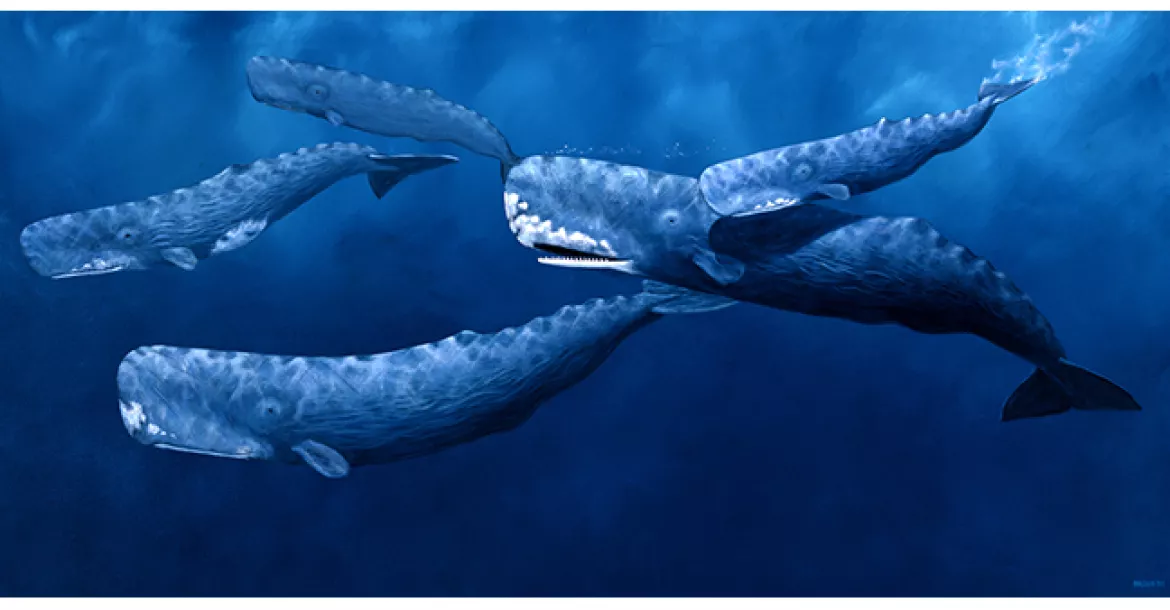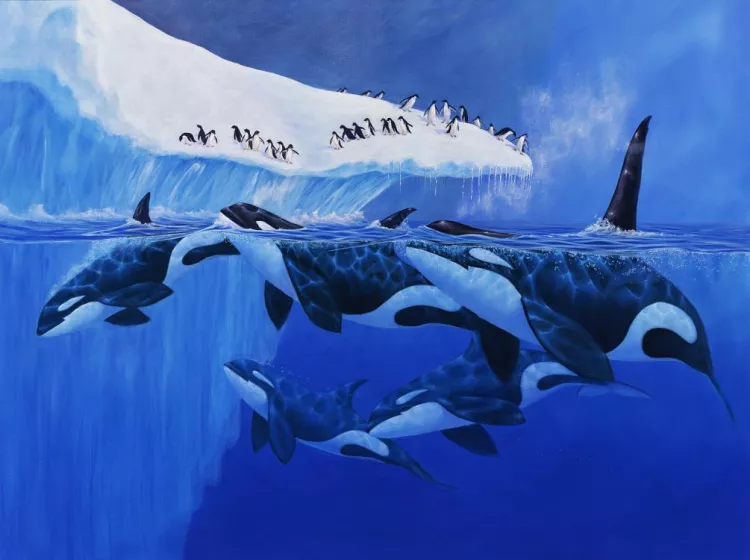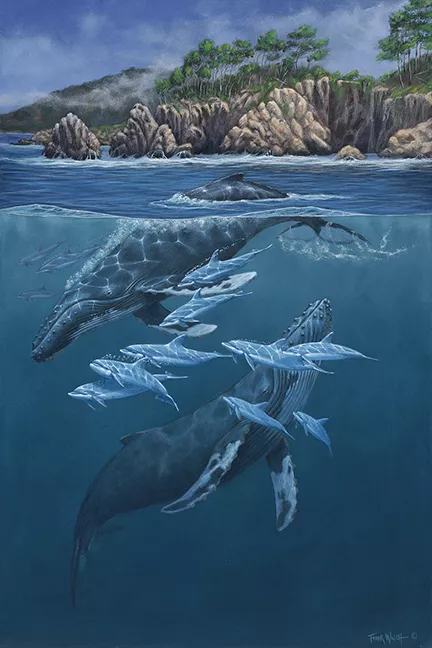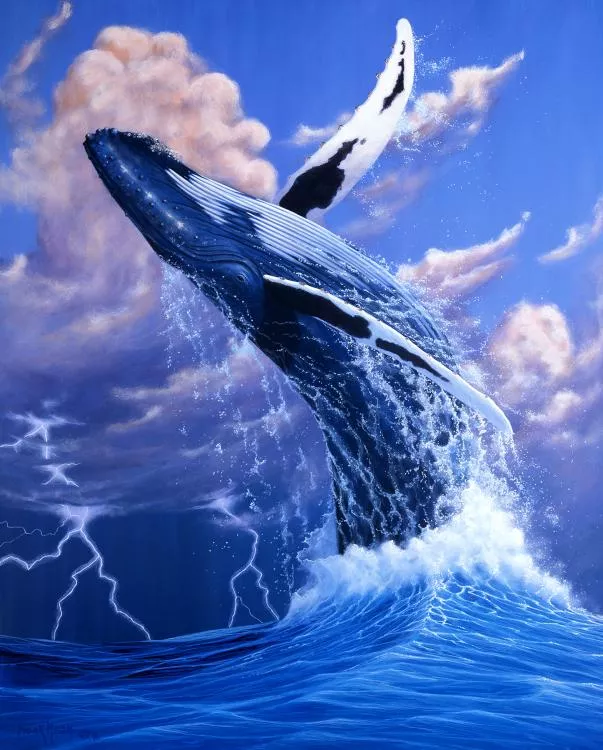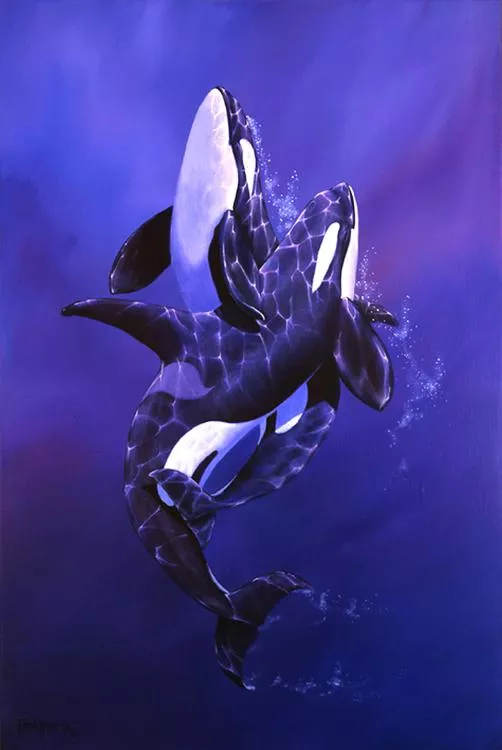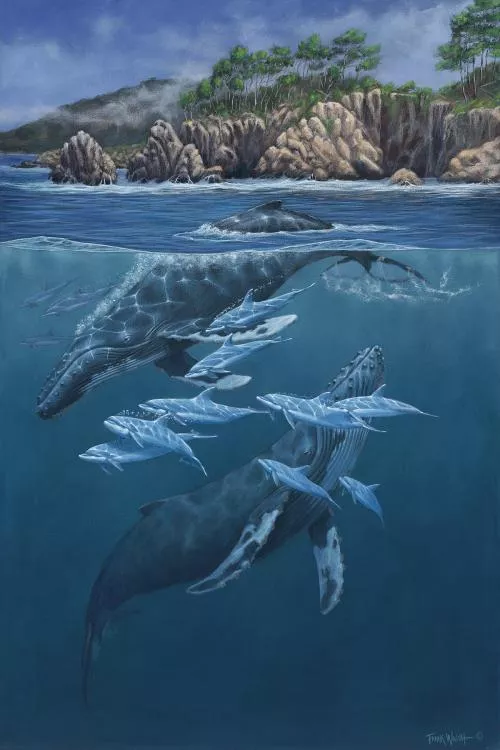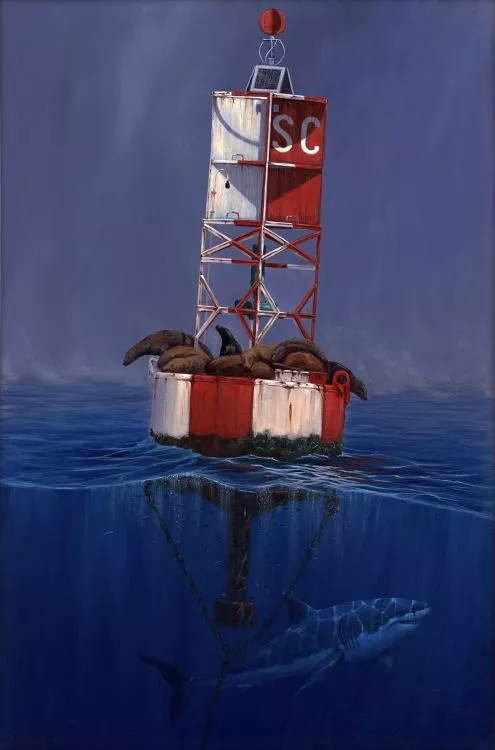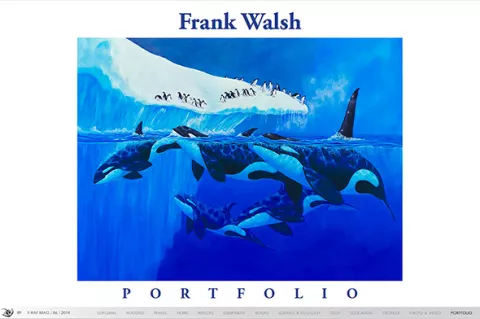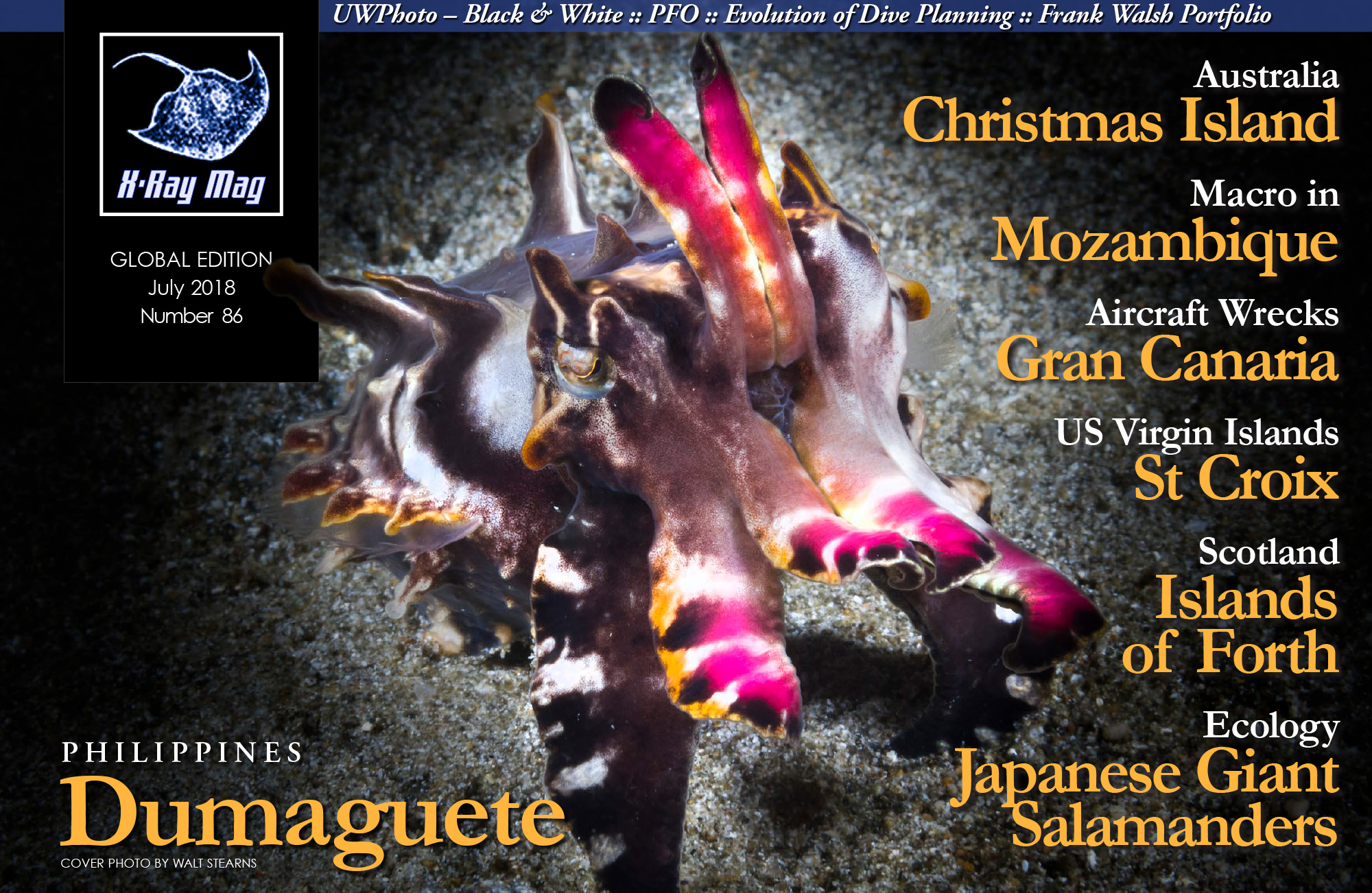An avid scuba and free diver, American self-taught artist Frank Walsh has captured his intense fascination of the sea and its creatures in brilliant, dynamic marine life paintings and sculptures for over 30 years. X-Ray Mag interviewed the artist to gain insight into his art and creative process, and how the underwater world inspires his creations.
Contributed by
X-RAY MAG: Tell us about yourself, your background and how you became an artist.
FW: I’m a self-taught artist born and raised in San Francisco. Like most kids, I always loved to draw and paint, but for me, that passion continued a lifetime. I was that kid in school that always colored inside the lines; maybe that’s why I’m a realist and love painting detail. I never considered art as a career. It was just a fun release for my imagination. Instead, I wanted to be a firefighter.
When I was 23, I got my wish and started a 28-year career in the fire service. I was married at the time and had a son. With that came the bills, so I started doing detailed pen-and-ink drawings of classic fire engines and selling them as prints. This eventually gravitated to my other interest, which was hunting and fishing. I started painting and selling sporting art in oils. It was a nice sideline, and I was still having fun.
Wildlife art was a hot ticket in the ’70s and ‘80s as well as the limited-edition print business. It seemed like everyone was jumping on the band wagon, painting fur and feathers. I hate crowds, so I wanted to try something else.
X-RAY MAG: Why marine life? How did you come to this theme and how did you develop your style of painting?
FW: In the early ‘80s, I tried my hand at marine life. I also switched to acrylics since I’m impatient and was tired of waiting for my oils to dry. It was a major learning curve for both, but I like challenges. Back then, there was not much reference to work with, other than photos in books or reruns of Jacques Cousteau TV series.
I strive for accuracy and want to know all there is about the subject I paint. The best way to do that is to dive into that world. So, I got my scuba certification in 1986, diving in the chilly marine life rich waters of Monterey Bay.
It was like nirvana for me. There are a number of world-class dive locations in the bay. One in particular I loved to dive was Blue Fish Cove at Pt. Lobos State Park. We would usually do two dives at around 90ft, so we could see the hydrocorals and strawberry anemone-covered walls. We would hit it with a light and the colors would explode. I’ve tried to replicate that scene many times without success. I’ve come to the realization you need to have God’s pallet.
Even though I was logging hours underwater, I never saw any marine mammals other than sea lions and harbor seals. My only encounter with whales was on the surface and those were gray whales. Then Humphrey the humpback whale visited San Francisco Bay and kept on going 70 miles up the Sacramento River until he reached Rio Vista. He spent a number of weeks on the river until he was finally coaxed into following humpback whale song recordings back out of the Golden Gate.
I, like millions of others, followed his epic journey on the nightly news. I did an above and below painting of Humphrey with the Golden Gate Bridge. That painting sold almost as quickly as I got it off the easel. I now knew what I wanted to paint.
In the early ‘90s, I finally got my chance to dive with humpback whales when I met Mark and Debbie Ferrari, of the Center for Whale Studies in Lahaina, Maui, Hawaii. I had done some graphic work for them and in return, I was able go out with them as an associate whale researcher. My first encounter was with a female humpback they called Pineapple who was with a newborn calf.
To this day, I will never forget the feeling I had when they passed within a few feet of me. I will always remember Pineapple’s eye following me as she passed. It was the start of a beautiful friendship with humpback whales. I had recorded every encounter on my Sony camcorder in a 25lb Ikelite housing. Looking back, it seems pretty rough compared to what you can get with a tiny GoPro today, but that vision will never fade from my brain.
During the ‘80s and ‘90s, there were only a few artists who were doing marine life art. There were a few of them that I admired. A couple of big names at the time were Robert Lynn Nelson in Hawaii, who coined the words “above and below” for his two world paintings; and George Sumner, who was an impressionist from San Francisco. Over the years, many artists have copied Nelson’s style, some to the extreme. On occasion, I too have painted the two worlds, but my painting style is quite different.
X-RAY MAG: What is your artistic method or creative process?
FW: I don’t think there is anything unique with my painting method. I first start with many small thumbnail sketches, most being nothing more than doodles. This helps me with composition and values. Depending on how involved the painting is going to be, will determine whether I do a detailed drawing that I will transfer to canvas.
One thing I don’t do is copy straight from a photo. I have a large collection of photos and videos I use for reference but never to copy. I know many artists are now using projectors to trace photos to their canvases, but I’m old school and still enjoy the drawing process. It could be frustrating at times when things are not working out but very satisfying when it does come together.
I prime my canvas or board with tinted gesso and then paint in my background color a few shades lighter than what it will be when finished. I do this since I usually use numerous color washes that will change the value and hue as I progress, giving a feeling of depth. I either draw directly on the substrate using a white charcoal pencil or caulk, or if it’s a finished drawing, trace it using transfer paper. The image is blocked in and values developed.
Over the years, I developed a system that I use for replicating refractive light below the surface. It is a slow process requiring numerous color washes. I use a hair dryer to speed the drying time between washes. I can’t count how many hair dryers I’ve burned up. I then finish off with my highlights and sign.
X-RAY MAG: What is your relationship to the underwater world and coral reefs? How have your experiences underwater influenced your art?
FW: As I grow older, I spend more time snorkeling than diving. Most of what I want to see is all within 20ft of the surface. I like the freedom of having nothing more than a good set of fins, mask and snorkel. Over the years, most of my diving has been in cold 52°F water wearing a 1/4 wetsuit, hood, gloves and booties. At my age, I’d rather not have to deal with that anymore.
For me, it really doesn’t matter whether I’m at 100ft or 10ft, there is always something I can take from my experience and use it in my art. I always carry a camcorder in a housing and now my GoPro. You never know what you will come across, for which it would be great to have a video reference.
That reminds me of a story. My dive partner, years ago, was the most avid diver I ever knew. He had been diving for years before I started and would be in the water at least two times a month. No camera, no spear gun—just him and the fish. He would laugh at me when I would take my camera when the visibility was like pea soup. He would always ask why I was bringing it. My reply would be that I wanted to be sure I had it in case we had a great white encounter. I said I could make a lot of money having video of him being eaten.
Well, he did have his great white shark encounter, but I wasn’t with him. That day, while he was diving at 100+ft, a 15ft great white circled him and then swam off into the abyss. He said his decompression stop seemed like an hour, with no video for the memories. It took him a couple of months before diving again.
X-RAY MAG: In your relationship with reefs and the sea, where have you had your favorite experiences?
FW: I’ve had many memorable encounters with various sea creatures while diving or snorkeling, but by far, the most incredible have been with humpback whales in the ‘90s. Many times, spinner dolphins would be accompanying them as well. One particular encounter was with a new born calf. The mother who was known as Spreckles, was a very friendly and approachable whale. Spreckles and her male escort took off leaving us to babysit. This little whale circled us for 20 minutes trying to get close. Each time she passed, she would reach out with her pectoral fin as if she wanted to touch us. This had to be the first time she ever saw a human and wanted to learn more about us. We had to continually back away. After about 20 minutes, mom and her boy-friend showed up and pulled the baby away. They used us as baby sitters while they partied somewhere. I have all this on video.
Second only to humpbacks was a very recent dive last May. I did a night dive in Kona, Hawaii, with manta rays. I’ve been wanting to do this for years and finally got my chance. We had up to eight manta rays cruising within inches of us for 40 minutes. Watching them feed on plankton was a mesmerizing sight. I highly recommend this dive and plan to return and do it again.
I’m currently putting the finishing touches on a painting of manta rays that I started after I returned. I’ve also been working on design layouts for a bronze sculpture of mantas that I hope to start shortly.
X-RAY MAG: What are your thoughts on ocean and freshwater conservation and how does your artwork relate to these issues?
FW: I’ve been a conservationist for as long as I can remember. I have been a member and contributor to many organizations that I felt were doing the most for areas I have the most concern. Just to name a few: the American Cetacean Society, the Billfish Foundation, the Center for Whales Studies, the Center for Marine Conservation, and the Guy Harvey Ocean Foundation. I have donated both prints and originals for fundraisers, and a percentage of my sales, to designated conservation organizations.
I am a signature member of an international group of 500 artists called Artists for Conservation (natureartists.com/conservation). For an artist to be selected, you must first be juried in and then commit to contributing at least 10% of all sales to a selected conservation organization. I’m quite proud to be part of this wonderful group of artists.
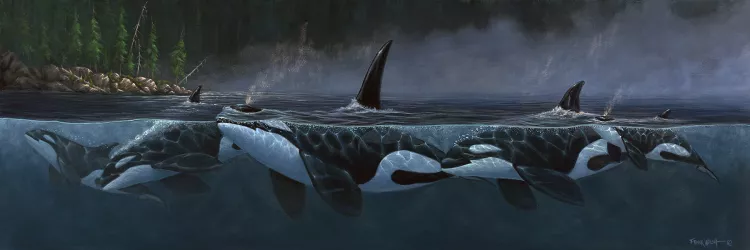
X-RAY MAG: What is the message or experience you want viewers of your artwork to have or understand?
FW: When I started out, life below the waves was alien to many. Most people only knew what they saw from photos or grainy film. Through my art, I wanted to show them more. I wanted to show them how beautiful and vibrant the colors are when you cut through the depths and shine a beam of light on a hydrocoral and strawberry anemone-encrusted wall 100ft below the surface. I wanted to show the beauty of a kelp forest undulate in the ocean surge as sunlight flashed through the forest. The only way I was able to experience this was by getting wet and deep. I was fortunate to be able to dive and wanted to share this with those who are not able. Hopefully with the knowledge we share, we can save this precious resource.
X-RAY MAG: What are the challenges and/or benefits of being an artist in the world today?
FW: I think being a professional artist is one of the most risky career decisions anyone can make. If you approach it with the intent of becoming rich and famous, you’re sure to be disappointed. There are so many talented artists out there who are struggling to make ends meet.
Getting gallery representation is always a challenge and even more difficult now since there seem to be fewer galleries… at least in my area. Overhead expenses have caused many well-known galleries to close. Wall space is expensive, and gallery owners want art they know is going to move.
Fortunately, if you are Internet and social media-literate, you can get your work seen by thousands of people. I’ve found people more willing than ever to purchase art online. With social media, more collectors are forming relationships and trust with artists and making purchases. Most young artists are very adept at navigating through all the social networks, but for some of us older folks, that can present a problem. I’ve spent many hours educating myself in this new world of self-marketing and have seen some success. It is time-consuming because it changes quickly, and you need to be up to speed, otherwise you will be left behind.
X-RAY MAG: How do viewers respond to your works?
FW: I always receive positive reactions, especially from children. They have been exposed through movies to so many of the critters I paint. The movie, Finding Nemo, was good for us marine life artists. Kids got entertained, and somewhat educated, and fell in love with the characters (fish). Someday, they will be young adults with money. Hopefully, they will still remember their childhood and want to hang some art that reminds them of that wonderful time.
X-RAY MAG: What are your upcoming projects, art courses or events?
FW: I’m glad you asked that… I’ve never been one to be content doing one thing. I’m always looking for ways to expand my horizons. A few years ago, I started sculpting. Again, I am self-taught, making many mistakes along the way. I will be starting to sculpt the clay for my manta ray bronze in a couple of weeks. I’m really excited about getting started on this after my recent dive.
After 30 years, I’m starting to work with oils again. I’ve been wanting to try my hand at plein air painting (painting in the open air, on location) and just recently started getting out and doing a few. I was surprised how quickly I became comfortable with the medium. What I did find difficult was loosening up. I am so conditioned to paint slow and tight that painting fast and loose is a real challenge. I need to work on the that—more reason to get out of the studio.
I still have a pretty lengthy bucket list of places I want to go and dives I want to make. After 35 years of painting marine life, things can become redundant, so these trips are needed to instill new enthusiasm. If anyone wants to follow and keep up with what I’m doing, please visit my website. While there, please be sure to sign up for my newsletter and go to my FaceBook link for Walsh Studios of Art and Design. ■
For more information, please visit: Frankwalshoriginals.com.
I strive for accuracy and want to know all there is about the subject I paint. The best way to do that is to dive into that world.
— Frank Walsh

